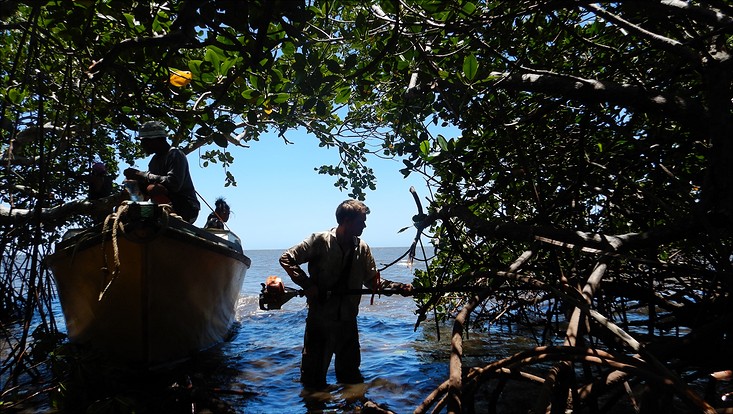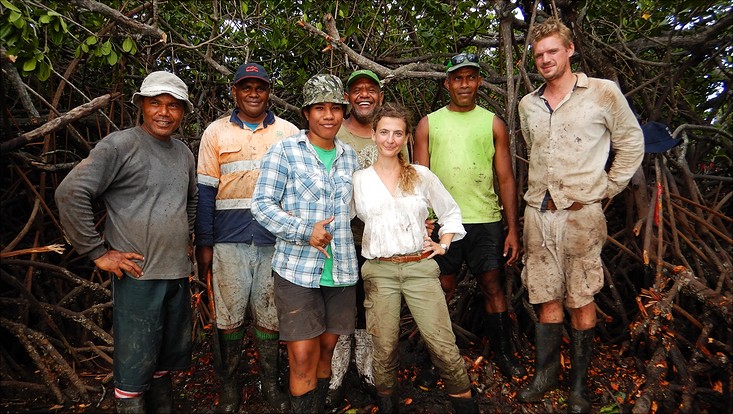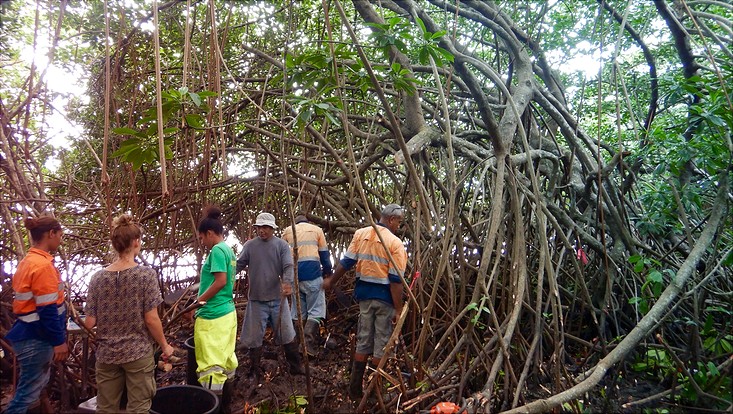How do mangroves protect our climate?
24 January 2018, by Giselind Werner
Two students of CEN researcher Prof. Dr. Michael Köhl spent four month in Fiji in order to develop a method for recording the biomass of mangrove forests and evaluating their carbon-storage capacity.
Mangroves, salt-water tolerant trees with characteristically high root systems, grow all along the coast of the South Pacific island of Fiji. Yet the data we have on how these mangrove forests store carbon is sparse. Fiji, the Pacific nation taking the lead in climate change, is at pains to close this gap. Burkhart Brielmeier and Sarah Reimer, two master’s students in wood science at Universität Hamburg, spent 4 months in Fiji in order to develop a method for recording the biomass of mangrove forests and evaluating their carbon-storage capacity.
What was the aim of your stay on Fiji?
Burkhart Brielmaier: To develop a method enabling us to create an inventory of the mangrove forests on Fiji so that we can calculate their capacity to store carbon. To do so, we had to record the biomass within pre-defined areas.
Sarah Reimer: A further task was to familiarize the local forestry officers and students with our method so that, in theory, the inventory can continue without our being present and it will be possible to carry out a national mangrove inventory.
What does it mean to “record biomass”? What does that entail?
BB: In our research, we work with so-called transects and we only take into account the wooden biomass above ground: that means no leaves and no roots under the soil. 4 months would be far too short for recording an entire plant. The sample areas in the transects measure 3 x 3 meters each, with a distance of 50 meters between each sample area.
SR: The most widespread mangrove species Rhizophora spp. grows like a weed. At most locations, it was impossible to say where the tree started and ended. This mangrove species also entwines itself with other trees and doesn’t develop a true trunk. That is why it is not possible to determine the number of trees per area, as we would do in a conventional inventory.
For this reason, we used a method known as “destructive sampling.” Basically, we documented our sample areas and then we chopped them up and weighed them. Instead of using measuring the volume, we evaluated density to estimate the wooden biomass. Once we have the biomass, we can then calculate the level of carbon.
And why is it useful to know how much carbon is stored in mangroves?
BB: In the Kyoto Protocol as well as at the Cop23, the UN Climate Change Conference in Bonn , and many other climate change meetings, the leading industrial nations have promised to help developing countries with climate change.
If, for example, the German federal government would like to support mangrove conservation on Fiji, we first need to know more about the importance of the mangrove forests. Without well-founded knowledge of the positive effects on the climate, no money will flow.
SR: Moreover, mangrove forests are a very important ecosystem: They purify water, transport biomass into the ocean—which is important for corals—and provide us humans with medicines or firewood. They also serve many fish species, such as sharks, as a breeding ground. And because they prevent erosion, they are also very important for coastline conservation.
What exactly did you have to do on a daily basis to achieve this?
SR: The social aspect plays a very important role. On Fiji, as on other Pacific islands, communities are governed by the “chief system.” This means that you need to introduce yourself in the village to whom the mangrove forest belongs. This takes place in a ritual called the Sevu Sevu, in which you state your intentions and offer a kava root. If the chief accepts the kava root, then you have been accepted as a member of the village and are free to carry out whatever you stated. Most of the time the chief gave us a boat with a guide who took us to our sample areas.
And who instructed you to do this project?
BB: Professor Dr. Michael Köhl from wood science asked us if we were interested. He has contacts in the German development agency GIZ (Gesellschaft für internationale Zusammenarbeit GmbH). Our project was part of the REED+ Program (Reducing Emissions from Deforestation and Forest Degradation and the role of conservation, sustainable management of forests and enhancement of forest carbon stocks in developing countries).
Fijian mangroves or central European mixed forests—what is your favorite?
BB: It is difficult to compare the two. Central European mixed forests are subject to heavy commercial use and are far removed from their natural states. Conversely, the mangroves build a highly sensitive ecosystem and are largely untouched by humans. Here nature has adapted to the most extreme conditions. And as such, working in the mangroves is an extreme experience. The tropical climate, the mosquitos, and the musty smell of the muddy ground add a particular flavor to our work: an Eldorado for any adventurer.
This article was first published here: Universität Hamburg
Information to the course of study (German only)
Contact
Faculty for Mathematics, Informatics and Natural Sciences
Department of Biology
Center for Wood Sciences
World Forestry
Tel: +49 40 73962-100
Email: michael.koehl"AT"uni-hamburg.de
Website Holzwirtschaft






